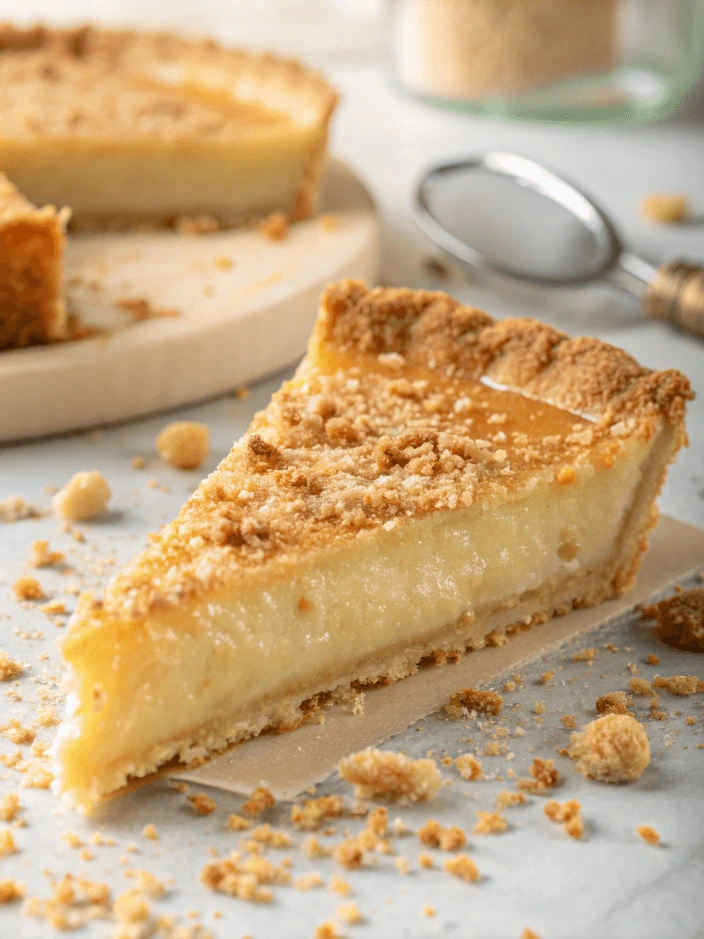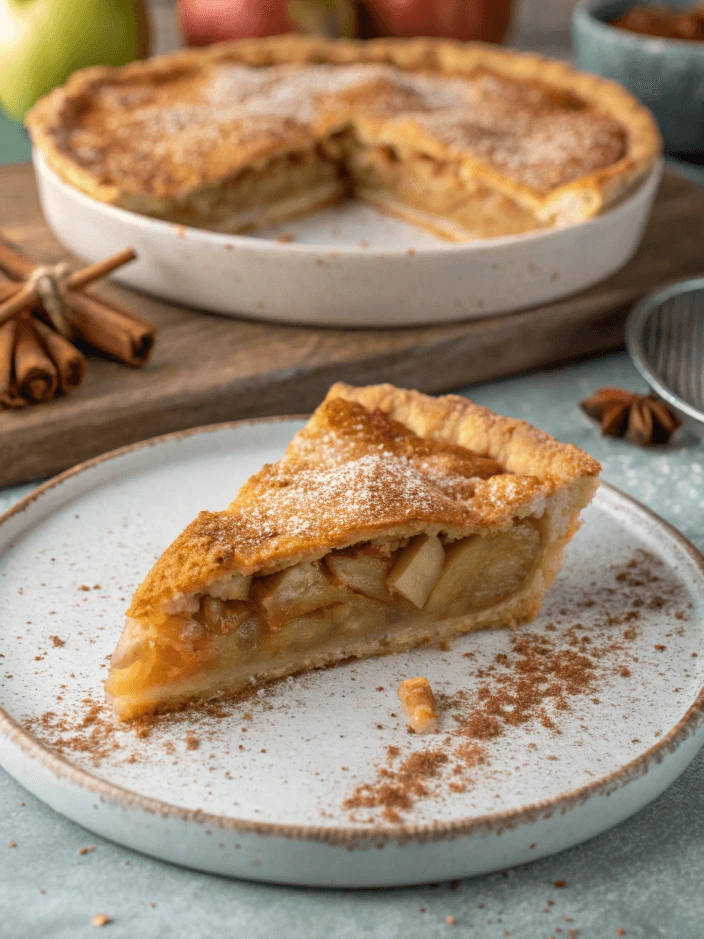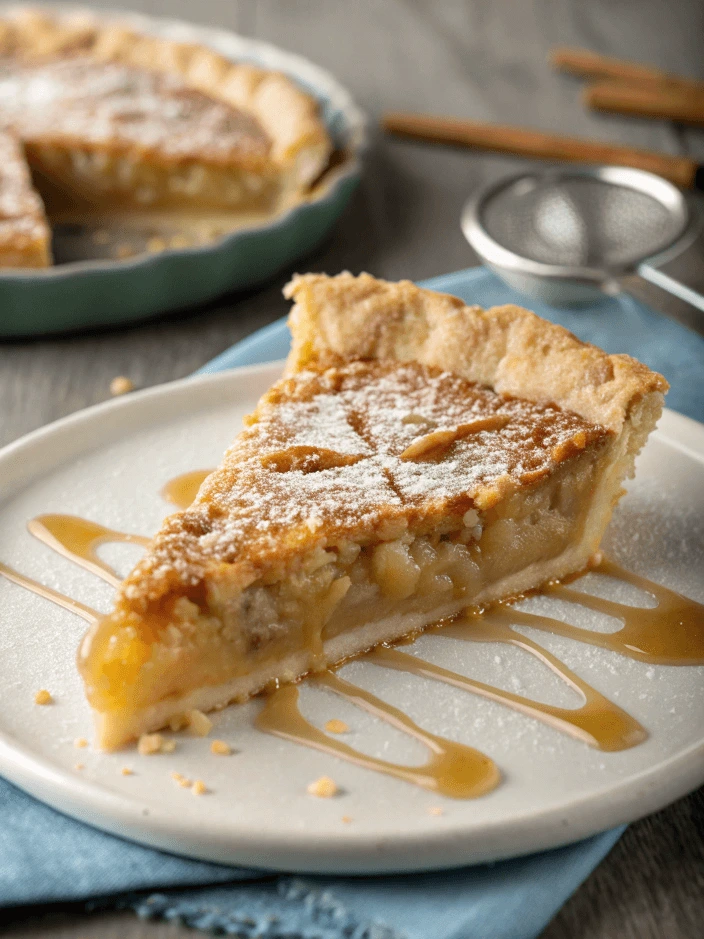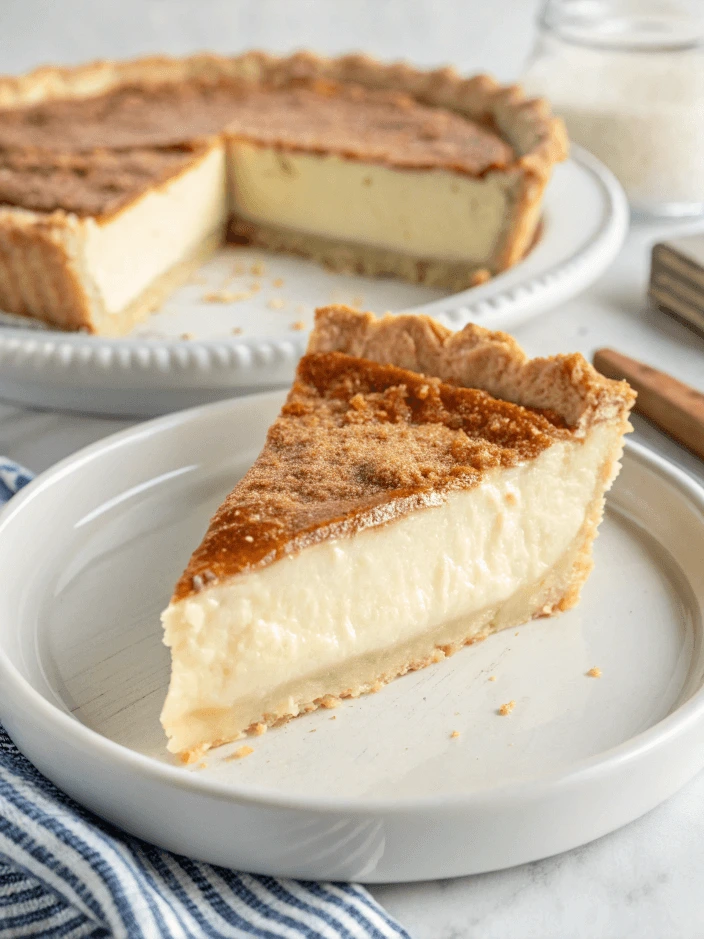Have you ever wondered what unusual dessert became popular during the Great Depression? Times were tough, ingredients were scarce, and people had to get creative in the kitchen. Yet, even in hardship, families found ways to enjoy something sweet. Instead of fancy cakes or rich pastries, they turned to simple, resourceful recipes—and one of the most surprising was water pie. With just a few pantry staples like flour, sugar, butter, and water, this dessert proved that you don’t need much to make something delicious.
Fast forward to today, and this forgotten dessert is making a comeback! First, it’s incredibly easy to make with ingredients you already have. Next, its light, buttery flavor makes it a nostalgic treat. Plus, it’s a fun way to experience history through baking. If you love trying simple yet fascinating recipes, you’ll want to keep reading to discover how water pie became a Depression-era staple!
Table of Contents
The Great Depression and the Rise of Unusual Desserts
Why Creativity Was Essential in Depression-Era Cooking
During the Great Depression, people had to make the most of what they had. Money was tight, and ingredients were scarce. Yet, families still wanted to enjoy something sweet and comforting. This led to the creation of resourceful, unusual desserts, including water pie.
Instead of relying on milk, eggs, or fresh fruit, bakers turned to pantry staples. Flour, sugar, and butter were among the few items they could afford. So, they got creative with simple recipes, often experimenting with water-based desserts.
In addition to creativity, waste was not an option. Every ingredient had to be used wisely. Families stretched their food supply by making desserts with minimal ingredients, and water pie was one of the best examples.
Here’s why creativity was essential for Depression-era desserts:
- Limited Ingredients: Bakers had to make desserts with what was available.
- No Food Waste: Leftovers and simple items were repurposed into meals.
- Simple Cooking Methods: Desserts had to be easy and require little preparation.
- Budget-Friendly Recipes: Families needed treats that wouldn’t strain their finances.
The ability to turn basic ingredients into delicious desserts is what made water pie and similar recipes so special. They were not just sweets; they were symbols of resilience and ingenuity.
How Limited Ingredients Led to Unique Recipes
Many desserts from the Great Depression era had one thing in common: simplicity. Since food was rationed, bakers had to find ways to replace common ingredients with whatever was available. This led to the creation of water pie, vinegar pie, and mock apple pie—all desserts that used unexpected ingredients to mimic traditional flavors.
Water pie, for example, used water instead of milk, making it affordable and easy to prepare. Instead of eggs, the recipe relied on flour and butter to create a custard-like filling. Sugar and vanilla were added for sweetness, making the pie taste surprisingly light and comforting.
Here’s how limited ingredients led to creative substitutes in Depression-era desserts:
| Traditional Ingredient | Great Depression Substitute |
|---|---|
| Milk | Water or vinegar + baking soda |
| Eggs | Flour and water mixture |
| Sugar | Honey, molasses, or syrup |
| Butter | Lard or shortening |
People didn’t just bake with these substitutions—they embraced them. Many of these creative recipes are still loved today, proving that hardship often leads to the most ingenious solutions.
Water pie may have started as a necessity, but it has since become a nostalgic dessert, enjoyed by those who appreciate its history and simplicity. Who would have thought that a dessert made with water could become a beloved classic?
If you want to experience this piece of culinary history for yourself, check out this water pie recipe and try baking it at home.
Water Pie – The Simple Dessert That Stood the Test of Time

What Makes Water Pie So Unique?
Water pie is one of the most unusual desserts from the Great Depression. Unlike traditional pies that use milk, eggs, or fruit, water pie relies on water as the main ingredient. This may sound surprising, but the result is a light, buttery, and custard-like dessert that is both simple and delicious.
One of the things that makes water pie so unique is its unexpected creaminess. Even though it doesn’t contain milk, the combination of sugar, butter, and flour creates a silky, smooth texture. The sugar dissolves in the water, forming a light syrup, while the butter melts and gives the pie a rich, comforting flavor.
Another unique aspect of water pie is its minimalist approach. Many Depression-era desserts required creative ingredient swaps, but this pie stuck to the basics. It’s proof that you don’t need complicated recipes to make something sweet and satisfying.
Here’s why water pie stands out:
| Feature | What Makes It Unique |
|---|---|
| Uses Water Instead of Milk | Creates a light, custard-like filling |
| Few Ingredients | Made with pantry staples |
| Easy to Prepare | No special baking skills required |
| Budget-Friendly | Perfect for difficult financial times |
Even though water pie was created out of necessity, it has continued to be enjoyed for generations. It’s a reminder that the simplest recipes are often the most comforting.
Despite its simple ingredients, water pie has a rich, buttery flavor that makes it a nostalgic favorite. If you’re curious about its taste, check out What Does Water Pie Taste Like? for a full breakdown of its flavor and texture.
Why Families Relied on Water Pie for a Sweet Treat?
During the Great Depression, families had to be resourceful. Desserts were considered a luxury, but people still wanted something sweet to bring comfort during hard times. Water pie became a go-to treat because it was affordable, easy to make, and required only a few ingredients.
Unlike other pies, water pie didn’t require fresh fruit, milk, or eggs—all of which were expensive or difficult to find. Instead, it used basic pantry staples that most households already had. This made it a reliable dessert that families could enjoy without stretching their budget.
Here’s why families depended on water pie:
- Affordable Ingredients: No expensive dairy or fruit required.
- Quick & Simple: Easy for anyone to make with minimal effort.
- Comforting Flavor: A buttery, sweet taste that felt like a real dessert.
- No Special Equipment Needed: Could be baked in any home oven.
Why Water Pie Was a Popular Choice During the Great Depression:
| Reason | Why It Mattered |
|---|---|
| No Perishable Ingredients | Lasted longer without refrigeration |
| Easy to Make | Anyone could bake it at home |
| Budget-Friendly | Perfect for low-income families |
| Tasted Like a Real Dessert | Gave people a sense of normalcy |
Even today, water pie continues to be enjoyed by those who appreciate its history, simplicity, and unique taste. It’s more than just a dessert—it’s a symbol of resilience and creativity in the kitchen!
Want to learn more about where water pie came from? Check out Where Did Water Pie Originate? for the full history behind this unique dessert!
Other Unusual Desserts from the Great Depression
Mock Apple Pie – A Pie Without Apples

Mock apple pie is one of the most unexpected desserts to come out of the Great Depression. Despite its name, it doesn’t contain any apples at all! Instead, it uses crackers or stale bread soaked in a spiced sugar syrup to mimic the texture and taste of apples.
Apples were expensive and often unavailable during the Great Depression. However, people still craved familiar flavors, so they got creative. The syrup, made with sugar, water, lemon juice, and cinnamon, gave the filling a sweet and tangy taste. When baked inside a flaky crust, it became almost indistinguishable from real apple pie.
The key to this recipe’s success was its ability to trick the taste buds. The crackers absorbed the syrup, softening into a fruit-like consistency. Many families served it with whipped cream or a sprinkle of cinnamon to make it even more convincing.
Here’s what made mock apple pie so popular:
| Feature | Why It Was Useful During the Depression |
|---|---|
| No Apples Needed | Allowed families to enjoy “apple pie” without apples |
| Used Leftover Crackers or Bread | Prevented food waste |
| Budget-Friendly | Made with affordable pantry staples |
| Familiar Taste | Mimicked traditional apple pie flavors |
Mock apple pie is still enjoyed today, often as a fun historical recipe. It’s amazing how resourcefulness turned simple ingredients into something truly special!
Vinegar Pie – A Surprisingly Tangy Classic

Vinegar pie may sound strange at first, but it was a common dessert when fresh fruit was hard to find. This pie used vinegar, sugar, butter, and eggs to create a filling that had a tangy, citrus-like flavor.
At a time when lemons were a luxury, vinegar became a clever substitute. The acidity of vinegar balanced the sweetness of the sugar, creating a bright, tart taste that resembled lemon pie. It was often baked with a simple pastry crust and topped with a dusting of cinnamon or nutmeg.
One of the best things about vinegar pie was its simplicity. Unlike fruit pies, it didn’t require peeling, slicing, or long preparation times. The ingredients were whisked together, poured into a crust, and baked until set. The result was a smooth, custard-like pie with a bold, unique flavor.
Here’s why vinegar pie became a Great Depression favorite:
- Tasted Similar to Lemon Pie: A great alternative when citrus fruits were unavailable.
- Used Common Ingredients: Made from vinegar, sugar, and butter.
- Easy to Prepare: Required minimal time and effort.
- Affordable Dessert: No expensive fruits or dairy needed.
Although it started as a survival recipe, vinegar pie has stood the test of time. It’s still made today as a nostalgic treat that reminds us of the past.
Sugar Cream Pie – A Budget-Friendly Sweet Treat

Sugar cream pie is often called “desperation pie” because it was created during times of hardship. It’s a rich, creamy dessert that requires no eggs, making it an affordable option when supplies were limited.
Instead of eggs, sugar cream pie relies on flour and butter to create its smooth texture. The filling, made from sugar, cream, butter, and vanilla, is whisked together and cooked until thickened. The result is a silky, custard-like pie with a sweet, buttery flavor.
Families loved this pie because it was simple to make and didn’t require refrigeration. The ingredients were always available, and the pie could be whipped up quickly for special occasions or everyday treats. Some variations included a sprinkle of cinnamon or nutmeg for added warmth.
Why was sugar cream pie so popular?
- No Eggs Required: Made with just sugar, cream, butter, and flour.
- Smooth, Custard-Like Texture: A rich, creamy alternative to traditional custard pies.
- Shelf-Stable Ingredients: Used ingredients that lasted a long time.
- Quick and Easy to Make: No complicated steps or special tools needed.
Comparison of Depression-Era Desserts:
| Dessert Name | Main Ingredients | Flavor Profile |
|---|---|---|
| Mock Apple Pie | Crackers, sugar, cinnamon | Sweet, apple-like taste |
| Vinegar Pie | Vinegar, sugar, butter | Tart, citrus-like flavor |
| Sugar Cream Pie | Sugar, cream, butter | Sweet, custard-like texture |
| Water Pie | Water, sugar, butter | Light, buttery, slightly sweet |
Sugar cream pie is still a beloved dessert in some parts of the U.S., particularly in the Midwest. It’s proof that even in the hardest times, people found ways to make something sweet and comforting.
Which one of these unusual desserts would you try first? It’s amazing how creativity in the kitchen led to recipes that are still enjoyed today!
Why Water Pie Became a Symbol of Resilience
How This Simple Dessert Gained Modern Popularity
Water pie may have started as a necessity during the Great Depression, but today, it has become a nostalgic favorite. As people look back on historical recipes, they appreciate the resourcefulness that went into making simple, delicious meals with few ingredients.
One reason for its revival is its ease of preparation. Unlike more complicated pies, water pie requires only a handful of ingredients that are already in most kitchens. People love recipes that are simple, budget-friendly, and surprisingly delicious, making water pie a perfect fit for modern bakers.
Another reason for its comeback is the growing interest in vintage recipes. More people are rediscovering Depression-era cooking, either for fun or to connect with family traditions. Water pie has become a way to experience history through baking while enjoying a light, buttery treat.
Here’s why water pie remains popular today:
| Reason | Why People Love It Now |
|---|---|
| Easy to Make | Requires only a few ingredients |
| Budget-Friendly | Perfect for saving money on desserts |
| Historical Appeal | Connects people to Depression-era recipes |
| Unique Taste | Light, buttery, and custard-like |
Water pie proves that simple recipes can stand the test of time. Whether you’re trying it for nostalgia or curiosity, it remains a symbol of resilience and creativity.
The Role of Social Media in Reviving Historical Recipes
Social media has played a huge role in bringing back forgotten recipes, and water pie is no exception. Platforms like TikTok, Instagram, and YouTube have introduced a new generation of bakers to this unusual but fascinating dessert.
One reason water pie gained traction online is because it’s unexpected. People love trying out recipes with surprising origins, and the fact that it’s made primarily with water makes it a curiosity-driven viral trend. Social media users enjoy the challenge of making historical recipes, and water pie is one of the most talked-about examples.
Here’s how social media has helped water pie go viral:
- TikTok Challenges: Users film themselves baking water pie for the first time.
- YouTube Tutorials: Cooking channels teach people how to make this Depression-era dessert.
- Instagram Reels: High-quality food photography showcases the pie’s creamy texture.
- Facebook Groups: People share family recipes and nostalgic stories about water pie.
Social Media’s Influence on Water Pie’s Popularity:
| Platform | How It Helped Water Pie Trend |
|---|---|
| TikTok | Viral baking challenges & first-reaction videos |
| YouTube | Step-by-step tutorials reaching millions |
| High-quality food photography & reels | |
| Nostalgic discussions & family recipe sharing |
Social media hasn’t just brought water pie back—it has made it a trend. Whether people bake it for fun, history, or curiosity, this simple dessert has found a new audience eager to keep the tradition alive.
Would you try making water pie after seeing it online? The internet has turned this humble dish into a global sensation, proving that even the simplest recipes can capture hearts!
Frequently Asked Questions (FAQs)
What was the most popular food during the Great Depression?
During the Great Depression, people ate simple, affordable meals made from basic ingredients. Dishes like beans and cornbread, potato soup, and rice with gravy were common. Many families stretched their meals by using leftovers creatively. In addition, casseroles made with bread, pasta, or canned vegetables helped food last longer. People became experts at making filling meals with very little.
What was a popular pudding during the Great Depression?
One of the most popular puddings was cornstarch pudding, made with milk, sugar, cornstarch, and vanilla. It was smooth, creamy, and easy to make. In addition, bread pudding was another favorite. It used stale bread, sugar, and milk to create a warm, comforting dessert. These puddings were simple, budget-friendly, and a great way to use up ingredients without waste.
What did people eat for dessert in the 1920s?
In the 1920s, people enjoyed fruit pies, custards, and sponge cakes as common desserts. Many households made apple pie, rice pudding, and chocolate cakes for special occasions. Ice cream also became widely available during this decade. Additionally, gelatin-based desserts, like Jell-O molds, were a fun and colorful treat. The 1920s brought a mix of homemade and store-bought desserts to American tables.
What did people eat for dessert before sugar?
Before sugar was widely available, people used honey, molasses, and dried fruits to sweeten their desserts. Ancient civilizations enjoyed honey cakes, fig-based treats, and fruit preserves. In medieval times, sweetened grains, nuts, and spiced pastries were popular. Many cultures relied on natural sweeteners like dates and maple syrup. Even without sugar, people found ways to make sweet and satisfying treats!
Conclusion: The Lasting Legacy of Depression-Era Desserts
What unusual dessert became popular during the Great Depression? Water pie was one of the most surprising, but it wasn’t the only one. Desserts like mock apple pie, vinegar pie, and sugar cream pie also helped families enjoy something sweet despite food shortages. These recipes were born out of necessity and creativity, proving that even in tough times, people found ways to make comforting meals.
Today, these desserts are more than just history. They remind us that simple ingredients can create something delicious. First, they showcase resilience. Then, they highlight how resourcefulness shaped food traditions. Now, thanks to social media, these recipes are making a comeback. If you’ve never tried one, why not bake your own slice of history? You might be surprised at how tasty these Depression-era treats can be. Which one will you try first?
